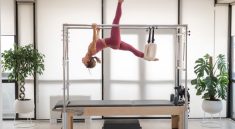Inspa Kyoto shares a simple daily flexibility training plan that helps improve mobility in just 10 minutes.
Why a Daily Flexibility Training Plan Works
A consistent daily flexibility training plan is more effective than a long stretching session once a week.
Short, regular routines train your muscles and nervous system to move through a fuller range of motion.
As a result, joints glide more smoothly, stiffness reduces, and movement feels lighter and more controlled.
Daily stretching also improves blood flow to tight areas, helping muscle recovery after workouts or long sitting hours.
Key Principles for Safe and Effective Stretching
Any daily flexibility training plan must start with safety.
Begin with gentle movements to warm the body before you push deeper into any stretch.
Never bounce or jerk; move slowly until you feel mild tension, then hold without pain.
In addition, keep breathing steady, inhaling through the nose and exhaling through the mouth during each stretch.
Good form matters more than how far you can reach, so avoid comparing your flexibility with others.
10-Minute Full-Body Flexibility Routine
This simple 10-minute daily flexibility training plan targets major muscle groups and key joints.
You can do it in your living room, office, or bedroom with no equipment required.
Hold each stretch for around 20–30 seconds and repeat once if time allows.
1. Neck and Shoulder Release
Stand or sit tall, relax your shoulders, and gently tilt your head toward one side.
Hold when you feel a soft stretch along the side of your neck.
Switch sides, then slowly roll your shoulders back in big circles to loosen the upper back.
2. Chest Opener for Better Posture
Clasp your hands behind your back and gently lift them away from your hips.
Open your chest, squeeze your shoulder blades together, and keep your chin slightly tucked.
This stretch helps counteract rounded shoulders from computer or phone use.
3. Standing Hamstring Stretch
Place one heel on a low step or chair, keeping the leg straight but not locked.
Hinge forward from the hips with a flat back until you feel tension in the back of your thigh.
Hold, then change legs, keeping both hips facing forward for better alignment.
4. Hip Flexor Lunge
Step one foot forward into a gentle lunge, lowering your back knee toward the floor.
Keep your torso upright and gently push your hips forward.
You should feel a stretch along the front of the back leg and into the hip area.
5. Seated Glute and Hip Stretch
Sit on the floor, cross one ankle over the opposite knee, and keep your back tall.
Lean your chest toward your crossed leg until you feel a stretch in your glutes and outer hip.
Switch sides and breathe slowly to help the muscles relax.
6. Cat-Cow Spine Mobility
Get on all fours with hands under shoulders and knees under hips.
Inhale as you lift your chest and tailbone, letting your belly drop.
Exhale as you round your spine, pushing the floor away and tucking your chin.
This controlled movement keeps the spine mobile and supports your daily flexibility training plan.
7. Calf and Ankle Stretch
Stand facing a wall, step one foot back, and press the heel into the ground.
Lean forward until you feel a stretch in the back calf.
Bend the back knee slightly to shift the stretch lower into the Achilles tendon.
8. Gentle Side Bend for the Torso
Stand with feet hip-width apart and raise one arm overhead.
Reach up and over to the opposite side, keeping your chest open.
Hold the stretch along the side of your body, then switch to the other side.
How to Fit 10 Minutes of Stretching Into Your Day
Embedding a daily flexibility training plan into your routine is easier when you attach it to existing habits.
Stretch after brushing your teeth at night or right after your morning coffee.
However, avoid intense stretching first thing if your body feels very stiff and cold.
Instead, walk around a bit or do light marching in place before you stretch.
Meanwhile, office workers can divide 10 minutes into short, two-minute breaks during the day.
Read More: How to increase flexibility safely with daily stretching habits
Common Mistakes That Limit Flexibility Gains
Many people follow a daily flexibility training plan but see little progress because of key errors.
Rushing through stretches without proper breathing keeps muscles tense instead of relaxed.
On the other hand, pushing into sharp pain signals the body to guard and tighten.
Skipping rest days after intense strength or cardio sessions can also reduce flexibility, as tired muscles resist lengthening.
Therefore, pair stretching with adequate sleep, hydration, and balanced training for best results.
Adapting the Routine for Different Fitness Levels
A beginner-friendly daily flexibility training plan should focus on smaller ranges and shorter holds.
If you are new, start with 10–15 second holds and avoid collapsing into any position.
As you progress, deepen each stretch gradually and extend holds to 30 seconds or longer.
After that, you can add tools like straps, yoga blocks, or a wall for extra support and intensity.
Nevertheless, always respect your current limits and adjust based on how your body feels each day.
Making Flexibility a Sustainable Long-Term Habit
The most effective daily flexibility training plan is the one you can maintain for months and years.
Choose stretches you enjoy and create a calm environment with music or soft lighting.
Track small wins, such as touching your toes more easily or sitting on the floor comfortably.
In addition, combine stretching with light strength work to stabilize new ranges of motion.
A strong, flexible body moves freely and feels better during exercise and everyday tasks.
By committing to a short, consistent daily flexibility training plan, you build mobility, reduce stiffness, and support long-term joint health.



